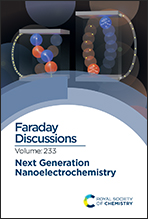An ultra-low noise amplifier array system for high throughput single entity analysis†
Abstract
Electrochemical measurements at the single entity level provide ultra-sensitive tools for the precise diagnosis and understanding of basic biological and chemical processes. By decoding current signatures, single-entity electrochemistry provides abundant information on charges, sizes, shapes, catalytic performances and compositions. The accuracy of single-entity electrochemistry highly relies on advanced instrumentation to achieve the amperometric resolution at the sub-picoampere level and the temporal resolution at the sub-microsecond level. Currently, it is still a challenge for paralleling amplifiers to allow low-noise and high bandwidth single-entity electrochemical measurements. Herein, we developed a low-noise four-channel electrochemical instrumentation that integrates an Au electrode array with amplifiers in the circuit board. With this amplifier array, we achieved a high bandwidth (>100 kHz) electrochemical measurement. The further practical experiments proved the capability of this amplifier array system in acquiring transient signals from both single-molecule detection with an aerolysin nanopore and single Pt nanoparticle catalysis during the dynamic collision process. Paired with appropriate microfluidic array systems, our instrumentation will enable an extraordinarily high-throughput feature for single-entity sensing.

- This article is part of the themed collection: Next Generation Nanoelectrochemistry


 Please wait while we load your content...
Please wait while we load your content...